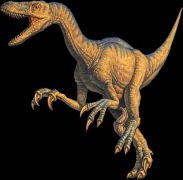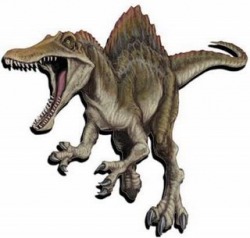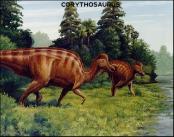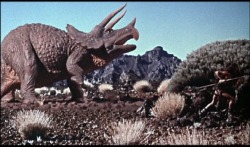Cretaceous Period
Tyrannosaurus Rex

The first real proof that Richard Owen had been right about dinosaurs being terrible was in 1908, when dinosaur hunters found the skull of a new dinosaur. It came from an animal that would have been able to look through a 18ft window, weigh more than a rubbish truck and had a mouthful of 8 inch long teeth like carving knife. Its head alone was over 4ft long. the dinosaur hunters had found Tyrannosaurs, the largest predator ever to walk the earth. tyrannosaurs probably hunted Hadrosaurs, supplementing its diet with an odd Triceratops.
Velciraptor

Velociraptor was a mid-sized dromaeosaurid, with adults measuring up to 2.07 m (6.8 ft) long, 0.5 m (1.6 ft) high at the hip, and weighing up to 15 kg (33 lb). The skull, which grew up to 25 cm (9.8 in) long, was uniquely up-curved, concave on the upper surface and convex on the lower. The jaws were lined with 26–28 widely-spaced teeth on each side, each more strongly serrated on the back edge than the front — possibly an adaptation that improved its ability to catch and hold fast-moving prey.
Spinosaurus

Although Spinosaurus is well-known to dinosaur enthusiasts due to its size, sail, and elongated skull, it is mostly known from remains that have been destroyed, aside from a few more recently discovered teeth and skull elements. Additionally, so far only the skull and backbone have been described in detail, and limb bones have not been found. Jaw and skull material published in 2005 show that it had one of the longest skulls of any carnivorous dinosaur, estimated at about 1.75 meters long (5.75 ft). The skull had a narrow snout filled with straight conical teeth that lacked serrations. There were six or seven teeth on each side of the very front of the upper jaw, in the premaxilla bones, and another twelve in both maxillae behind them. The second and third teeth on each side were noticeably larger than the rest of the teeth in the premaxilla, creating a space between them and the large teeth in the anterior maxilla; large teeth in the lower jaw faced this space. The very tip of the snout holding those few large anterior teeth was expanded, and a small crest was present in front of the eyes.
Corythosaurus

Corythosaurus, meaning 'helmet lizard' because of the shape of its crest (Greek korythos meaning 'helmet' and sauros meaning 'lizard') was a genus of duck-billed dinosaur from the Upper Cretaceous Period, about 80 million years ago. It lived in what is now North America.
Triceratops

Individual Triceratops are estimated to have reached about 7.9 to 9.0 m (26.0–29.5 ft) in length, 2.9 to 3.0 m (9.5–9.8 ft) in height, and 6.1–12.0 tonnes (13,000-26,000 lb) in weight. The most distinctive feature is their large skull, among the largest of all land animals. It could grow to be over 2 m (7 ft) in length, and could reach almost a third of the length of the entire animal. It bore a single horn on the snout, above the nostrils, and a pair of horns approximately 1 m (3 ft) long, with one above each eye. To the rear of the skull was a relatively short, bony frill. Most other frilled dinosaurs had large fenestrae in their frills, while the frills of Triceratops were noticeably solid.
